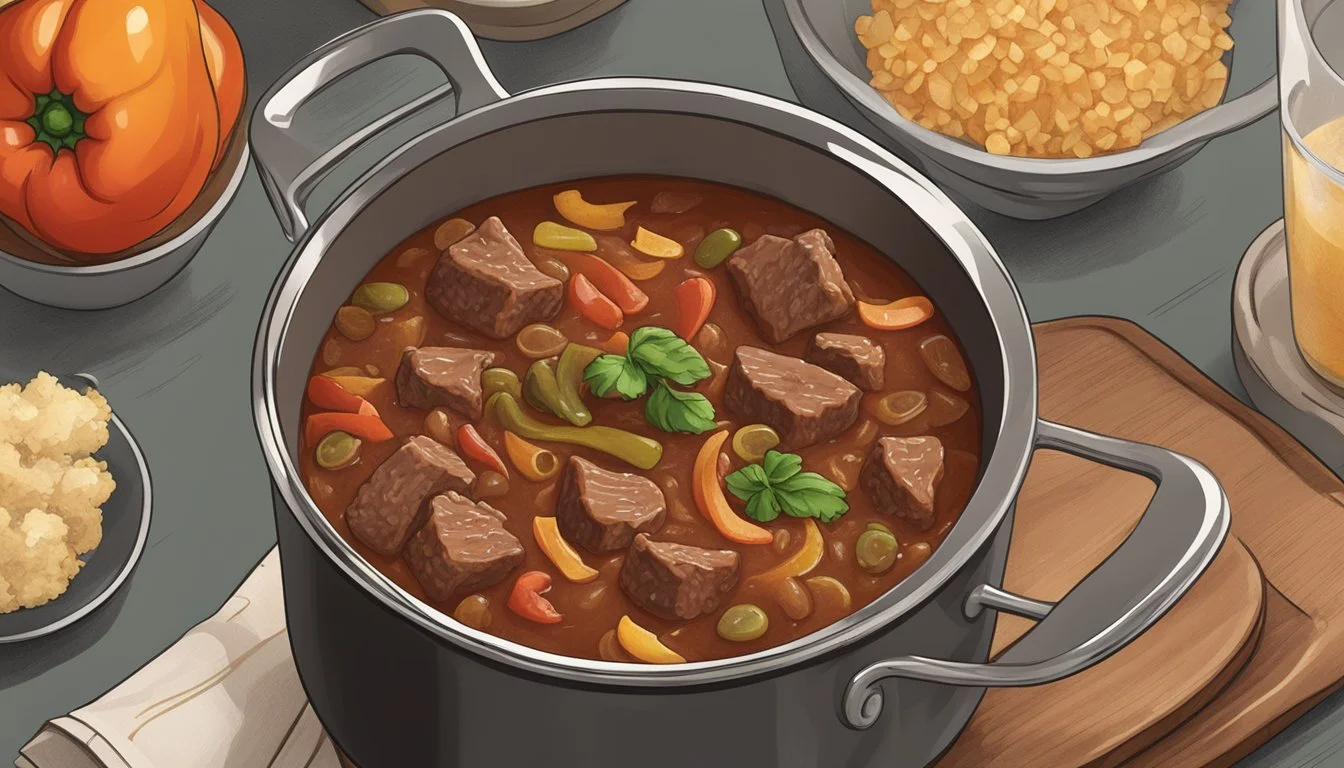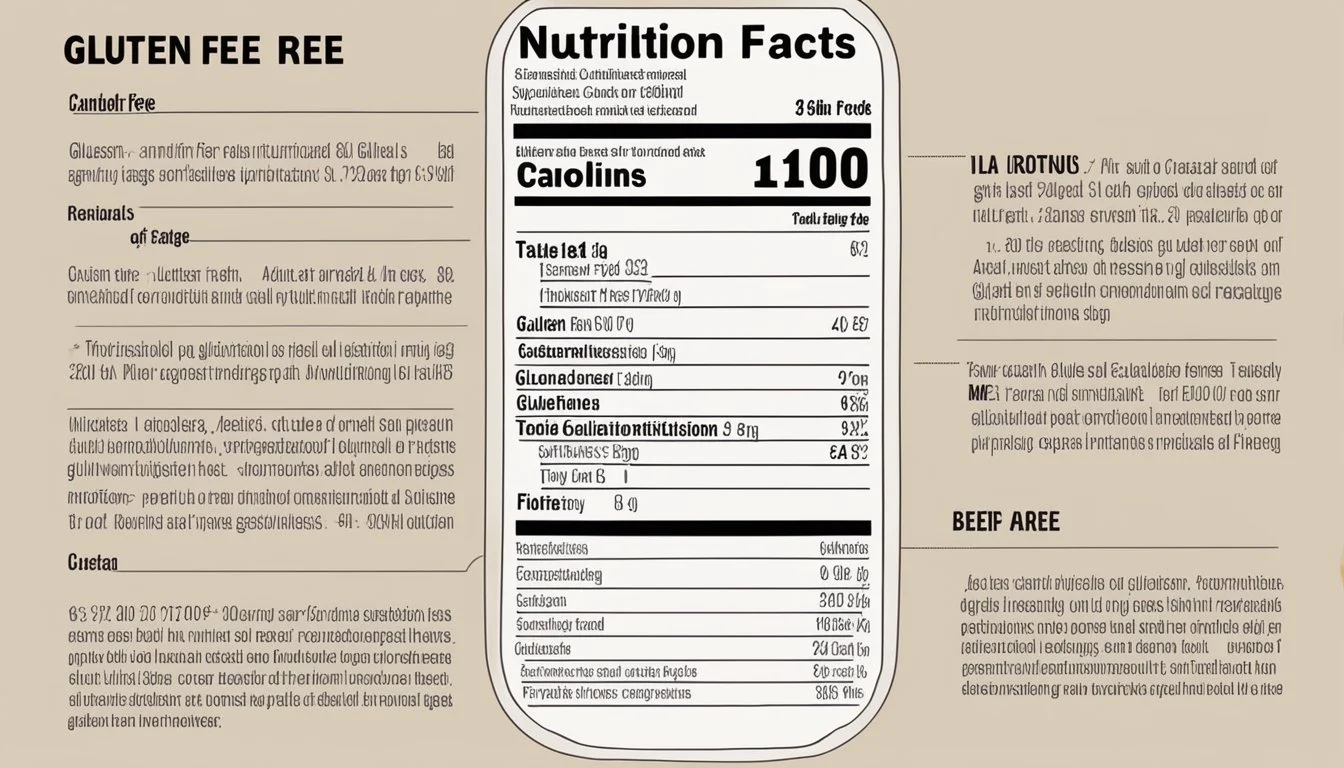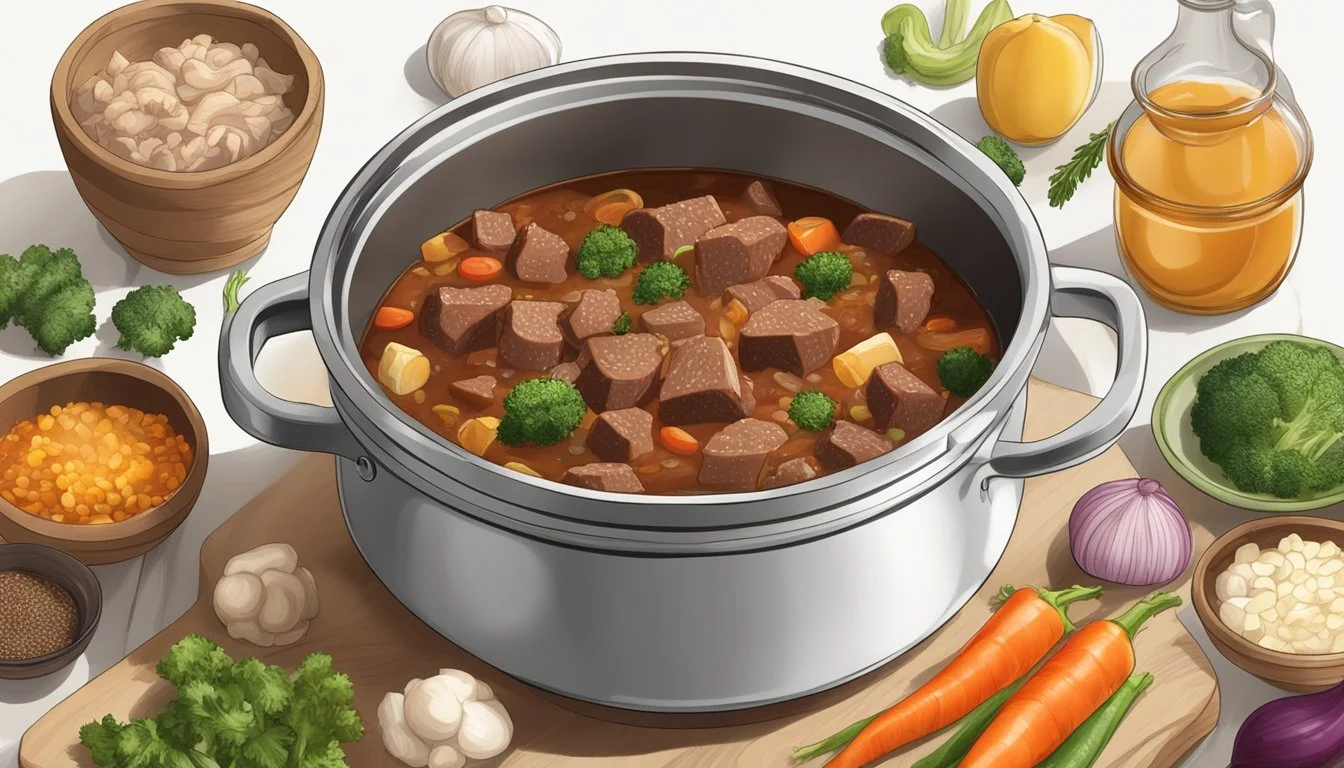Is Beef Goulash Gluten-Free?
Understanding Ingredients and Preparation Methods
Understanding whether beef (What wine goes well with beef?) goulash is gluten-free requires an examination of its ingredients and preparation methods. Beef goulash, a hearty stew originating from Hungary, traditionally includes beef, vegetables, and the distinctive spice of paprika. While these base ingredients are inherently gluten-free, gluten can be introduced through certain additives or when using ingredients like flour as a thickener or in pasta included in some versions of the dish. Consequently, those adhering to a gluten-free diet need to scrutinize goulash recipes and product labels closely.
The preparation of beef goulash varies by region and personal preference, which can affect its gluten content. In its most authentic form, Hungarian goulash should be gluten-free, using only meat, vegetables, and spices. However, American adaptations of goulash often include elbow macaroni or other pasta, which typically contains gluten unless specified otherwise. To ensure a gluten-free meal, one must use gluten-free pasta, or omit it entirely, and be vigilant about the use of gluten-free beef stock and seasonings.
With the rise of gluten sensitivity and celiac disease, many recipe creators and food manufacturers are adapting this classic dish to meet gluten-free dietary needs. This involves using gluten-free thickeners such as cornstarch or potato starch and verifying that all spices, including paprika, are free from gluten contamination. Furthermore, any accompanying bread or side dishes should also adhere to gluten-free standards to maintain the integrity of a gluten-free goulash meal.
Essential Ingredients for Beef Goulash
Creating authentic beef goulash requires careful selection of meat, fresh vegetables, traditional seasonings and spices, and a hearty base. When preparing this dish, one must pay special attention to gluten-free alternatives to ensure adherence to dietary restrictions.
Meat Selection
Beef is the traditional choice for goulash, with chuck offering a good balance of flavor and tenderness. Alternative meats such as pork or venison (What wine goes well with venison?) can be used for variation. It is important to brown the meat properly to develop a rich flavor.
Vegetable Add-Ins
Essential vegetables in beef goulash include chopped onions, (What wine goes well with onions?) often yellow or white, and bell peppers (What wine goes well with bell peppers?) for sweetness. Tomatoes, potatoes, and carrots add depth and substance to the dish, with diced tomatoes or canned tomatoes serving as a convenient option.
Seasoning and Spices
The characteristic taste of goulash comes from Hungarian paprika. Additional spices such as garlic, caraway seeds, bay leaf, and marjoram contribute to the complex flavor profile. Salt and pepper are used for basic seasoning, with variants such as seasoned salt, cayenne pepper, or thyme enhancing the dish.
Building the Base
For the base of the goulash, beef broth provides richness, while tomato paste or tomato sauce adds body and tanginess. Olive oil is commonly used for sautéing. A thicker consistency can be achieved with the addition of gluten-free flour or starch.
Gluten-Free Considerations
To ensure the dish is gluten-free, all ingredients including pasta, if used, must be certified gluten-free. This applies to any flour used for thickening as well. Gluten-free alternatives, like gluten-free elbow macaroni or gluten-free all-purpose flour, should replace traditional wheat-containing ingredients. Use gluten-free labeled beef broth and condiments to avoid hidden gluten.
Goulash Preparation
When preparing beef goulash, attention to detail in cooking techniques and ingredients ensures a hearty and flavorful meal. Whether you're utilizing traditional Hungarian methods or more contemporary approaches, the goal is a rich and savory stew.
Cooking Techniques
Goulash typically begins with browning beef, which provides a deep, caramelized flavor base. It's essential to use a thick-bottomed pot, such as a Dutch oven, to prevent scorching and ensure even cooking. After browning the meat, aromatics like onions are cooked until they're softened, which can take about 10 minutes.
Step-by-Step Instructions
The beef is often cut into uniform, bite-sized pieces to promote even cooking. The key steps include:
Browning the beef: In a large pot, sear the beef pieces until browned on all sides.
Sautéing aromatics: Add sliced onions (for a Hungarian variant) or shallots with minced garlic and sauté.
Introducing liquids: Stir in liquids such as broth, water, or red wine—red wine vinegar can also be added for acidity.
Including key spices: Essential to the goulash are spices like paprika; Hungarian recipes emphasize sweet paprika for authenticity.
Simmering: Let the stew simmer, partially covered, for at least 30 minutes, allowing the flavors to develop.
At this point, the stew can be enhanced with additional ingredients such as tomatoes and peppers, and in non-traditional versions, gluten-free elbow macaroni.
Alternative Cooking Methods
The traditional stovetop method is not the only way to prepare goulash:
Oven preparation: After combining ingredients on the stovetop, the Dutch oven can be placed in a preheated oven, allowing the stew to cook slowly and become tender.
Slow cooker: For convenience, a slow cooker can be used. Combine seared beef and sautéed onions with the rest of the ingredients and cook on low for several hours.
Freezing: Goulash freezes well. Once cooled, portion it into freezer-safe containers for easy reheating.
Regardless of the method, one can finish the dish with a dollop of sour cream to add richness and balance the flavors.
Nutritional Information
When assessing the nutritional content of beef goulash, one must consider both the macronutrients and the relevant vitamins and minerals within the dish. This food item typically includes beef as a primary ingredient, along with a variety of vegetables, sometimes paired with broth or wine, and can be adapted to be gluten-free.
Macronutrients
Calories: Traditional beef goulash can vary in caloric content depending on the preparation method, but an average serving contains approximately 250-350 calories.
Fat: A serving may contain between 10-15 grams of fat, with a portion of that being saturated fat. The exact amount of fat is contingent upon the cut of beef used and the cooking technique.
Cholesterol and Sodium: Beef goulash contains cholesterol and sodium, naturally present in beef and added seasonings. Sodium content can be significant, especially if prepared with pre-made broths high in salt.
Carbohydrates: In gluten-free versions, the absence of traditional wheat-based noodles or dumplings reduces the carbohydrate content. If gluten-free pasta is used, the carbohydrate level will primarily depend on the amount and type of pasta incorporated.
Fiber: The vegetable components—such as onions, garlic, and tomatoes—add dietary fiber.
Protein: Beef is an excellent source of high-quality protein, contributing to the dish's significant protein content.
Vitamins and Minerals
Potassium: Beef and tomatoes provide potassium, essential for blood pressure regulation and cardiovascular health.
Vitamin A: Present in the dish through tomato products and any additional vegetables like carrots, vitamin A supports healthy vision and immune function.
Vitamin C: Tomatoes and any bell peppers included in the recipe are sources of vitamin C, important for collagen production and immune defense.
Calcium: While not high in calcium, the presence of this mineral can be attributed to any dairy used in cooking, such as butter, or if cheese is added as a garnish.
Iron: Iron, critical for the transportation of oxygen in the body, is abundant in beef, making beef goulash a good source for this mineral.
Modifications and Substitutions
Making beef goulash gluten-free requires careful attention to ingredients and awareness of cross-contamination risks. The following subsections provide specific guidance on how to substitute and adjust components within your goulash recipe.
Gluten-Free Adjustments
To ensure your beef goulash is gluten-free, one must replace ingredients that typically contain gluten with gluten-free alternatives. Wheat-based items like traditional flour and pasta can be substituted with gluten-free flour and gluten-free pasta, keeping the same textures and thickness typical of a goulash.
Flour: Use gluten-free flour blends for dredging meat or thickening the goulash.
Pasta: If incorporating pasta, opt for gluten-free elbow macaroni or other gluten-free pasta shapes.
It's imperative to check that all packaged ingredients, like Worcestershire sauce, are labeled gluten-free, as they can sometimes contain hidden gluten.
Meat and Vegetable Variations
While beef, specifically beef chuck, is traditional in goulash, one can substitute it with other meats like ground beef for a quicker cook time or different textures. For a dairy-free option, cooking oils or plant-based butter can replace dairy products used in the browning process.
Beef Alternatives:
Ground beef (faster cooking)
Beef chuck (traditional, longer cooking)
Dairy-Free Options: Use plant-based butter or oil for sautéing.
Variations in vegetables can also add depth; bell peppers, tomatoes, onions, and garlic are standard, but feel free to include additional vegetables to your preference.
Flavor Enhancers and Additives
The flavor profile of gluten-free goulash can be enriched without compromising gluten-free integrity.
Broth: Choose a gluten-free beef or chicken broth as the stewing liquid.
Seasonings: Paprika is central to goulash, but always verify that it is gluten-free. Fresh herbs and spices can enhance the flavors further.
Sweeteners: If a recipe calls for sugar, it can be used, or one could opt for alternatives like honey.
Remember to read labels and select seasonings without added gluten-containing compounds. Additives like thickeners or stabilizers in pre-packaged items should be gluten-free certified. Care in selecting additives like rice, sugar, or gluten-free Worcestershire sauce will maintain the dish's gluten-free status.
Preservation and Storage
Proper storage techniques are essential to preserve the flavors and extend the shelf life of beef goulash. It's important to note that the way one stores and reheats the goulash, as well as the methods used to freeze it, can significantly impact its quality.
Storing and Reheating
For optimal freshness, refrigerate leftovers within two hours of cooking. Store beef goulash in an airtight container to avoid the absorption of other flavors from the refrigerator. Use a shallow container to allow for quick cooling, thus reducing the risk of bacterial growth. When reheating beef goulash, ensure it reaches an internal temperature of 165°F (74°C), as this temperature kills most bacteria. Reheat only the portion to be eaten to avoid multiple heat cycles that can deteriorate the dish's quality.
Freezing Techniques
When freezing beef goulash, let it cool to room temperature before transferring it to a freezer-safe container or bag. Remove as much air as possible from freezer bags to prevent freezer burn. Clearly label the container with the date of storage. Beef goulash can be frozen for up to three months without significant loss of taste or texture. To thaw, it's best to place the goulash in the refrigerator overnight.
Extended Shelf Life Tips
To extend shelf life, consider adding natural preservatives like vinegar or sugar to the goulash; these ingredients can help inhibit bacterial growth. However, use these additives according to the recipe's recommendations to avoid altering the traditional flavor profile of the goulash. Regularly check the refrigerator's temperature to ensure it's at or below 40°F (4°C), the safe zone for food storage. For the freezer, maintain a temperature of 0°F (-18°C) to preserve the goulash's quality.
Serving Suggestions
When preparing a gluten-free beef goulash, it's important to consider what to serve it with to make a wholesome and satisfying meal. The accompaniments and garnishes can greatly enhance the flavors and provide a balanced dish.
Accompaniments
For those adhering to a gluten-free diet, serving gluten-free pasta such as elbow noodles, is a traditional and comforting choice to accompany Hungarian goulash. Alternatively, mashed potato or plain rice provide a hearty base that can absorb the rich flavors of the goulash. One can even explore various gluten-free options such as quinoa or millet for a nutritious twist. For a different take on the dish, American goulash pairs well with a side of steamed vegetables or a crisp salad.
Gluten-Free Pasta: A classic side, ensuring it complements the goulash without containing gluten.
Rice: A neutral base that works well with the bold goulash flavors.
Mashed Potato: Creamy and savory, making it a perfect gluten-free option.
Dairy-Free Alternatives: For those avoiding dairy, opt for rice, quinoa, or dairy-free mashed potatoes.
Garnishing Ideas
To elevate the dish, thoughtful garnishing can add a burst of flavor and color. A dollop of dairy-free sour cream adds a creamy texture and tangy taste, complementing the rich sauce of the goulash. Fresh basil or other herbs can be sprinkled on top for an aromatic touch. When serving, one might consider these garnishing elements to enhance both the visual appeal and the taste complexity of the goulash.
Dairy-Free Sour Cream: Offers a creamy contrast without the dairy.
Herbs: Basil, parsley, or chives can add freshness to each serving.
Frequently Asked Questions
Is traditional beef goulash gluten-free?
Traditional beef goulash typically includes stew meat, root vegetables, and seasonings. However, it can contain gluten through certain ingredients, such as flour used as a thickener or certain brands of soy sauce.
What substitutions can make beef goulash gluten-free?
One can use gluten-free alternatives for any ingredient that typically contains gluten. This includes:
Gluten-free beef broth
Gluten-free dry onion soup mix
Gluten-free flour (as a thickener if necessary)
Are there any other allergens or dietary concerns in beef goulash?
Beef goulash may include allergens such as dairy if cream is added, and it may not be suitable for those following a vegetarian or vegan diet due to the beef content. Always check the full list of ingredients if allergies or dietary restrictions are a concern.
How does one ensure that the goulash is truly gluten-free?
When preparing gluten-free goulash, they must:
Verify that all packaged ingredients are labeled gluten-free.
Avoid cross-contamination with gluten-containing products during preparation.
Use separate utensils and cookware that haven't been in contact with gluten.
Remember, for those with severe gluten intolerance or celiac disease, even trace amounts of gluten can cause adverse reactions. It is crucial to follow gluten-free guidelines strictly when preparing the dish.







